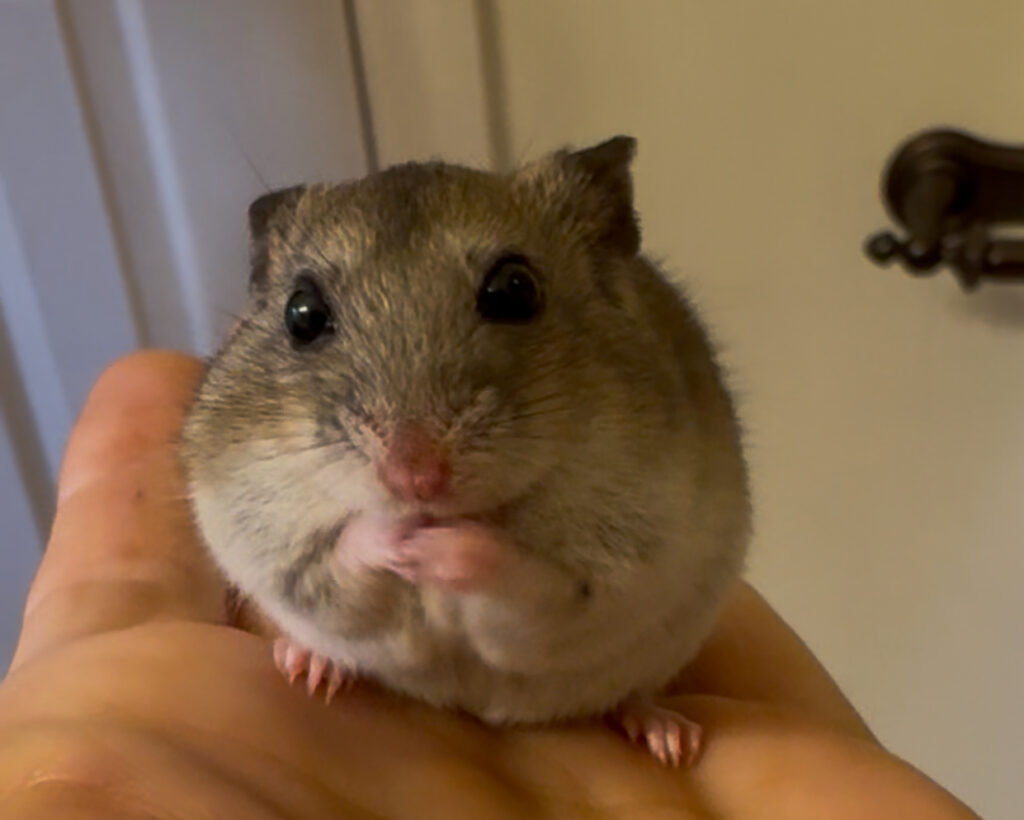
Giving in–and learning along the way.
After months–honestly, it was years–of avoiding what felt like our children’s inevitable acquisition of small, furry rodent animals to serve as pets, and after successfully weaving between the pitiful pleas of kids number one and two–those eyes, those knowing looks of disappointment–I finally (finally!) acquiesced. Annie wanted a hamster. And I was too worn down to object. I held out for what should have been an appropriate amount of time. Even the most dogged defenses, it turns out, have vulnerabilities.
Mine began with a PowerPoint deck.
It’s only appropriate. How perfect that the chink in my armor involved a slide deck and an impassioned pitch. How pathetic that at nine years old, Annie had me figured out.
To be clear: the slide deck was really about getting a rabbit. Annie has obsessed over the ones that hop into our yard, chewing clover, hiding warrens, and occasionally falling victim to nature’s blood-red jaws. Her presentation involved an aspirational goal (an indoor rabbit) with an “I’ll settle for” goal (an outdoor hutch/rabbit) being the pre-decided compromise strategy. Annie delivered the presentation beautifully. One day, it’s quite possible she will conclude remarks to the rapturous applause of a cavernous auditorium. Or to the affirmed commitment of tens of millions of dollars in venture capital from a board room.
That day, however, I dug in my heels and held firm. No rabbit. No hutch. Who would care for them when we went on vacation? I asked. She saw the cracks in the façade, though. It was only a matter of time.
Water began flowing around the dam the day they brought home a wayward mouse they’d picked up on the greenway, one that had either been struck silly in the head or suffered such a raging ear infection that it was only capable of spinning around in circles on the trail. Annie gathered the little thing into her croc. It was then installed in a small, plastic pet container at the house and provided sumptuous lodging, food, and comfort.
I objected, of course–boldly to Kelly and half-heartedly to Annie. It was a wild mouse. Surely they carried disease. After all, wasn’t it wild mouse waste that sparked the mysterious and mercilessly fatal disease that killed Gene Hackman’s wife, the tragic death that brought poor, memory-struck Gene Hackman to his own demise? If feral mouse urine could bring down Lex Luther, what chance did we stand?
Annie (wisely) ignored all of my protestations, donning blue nitrile gloves when she handled her patient, taking special care to not get nipped at, dutifully cleaning its cage. Later, whatever viral disease seeds I’d planted in Kelly’s mind began to bear fruit. It probably wasn’t a good idea to foster a wild mouse in the house.
How, then, do we negotiate its eventual return to the wild?
The dam broke. Conveniently, it was her birthday. The wayward mouse was granted parole back into the wild with a full belly and a lot of well wishes. Quickly taking its place in the household rodent census: one pet shop hamster, complete with the standard beginner’s supply of hamster paraphernalia: cage, shavings, wheel, and so forth. Annie named her Maggie.
Knowing a hamster’s innate ability to escape its containment, Kelly kept Maggie’s crate overnight in the kids’ bathtub. Millie quickly became obsessed with what must have appeared to her as a fully autonomous squeaky toy. The immediate nightmare scenario in my brain involved a single snap of our three-legged doodle’s mouth.
It never materialized, though. Soon, the entry-level crate was upgraded to a large plastic storage bin, the kind you might use to keep sweaters in over the winter, and inside the kids used Magna-tiles to design a comprehensive hamster castle, complete with tunnels, climbing areas, and observation windows. Hours of time were spent.
To evidence my thorough defeat, one hamster became two. Maggie welcomed a sister hamster from the brood at the pet shop, and Julia christened her new pet Celine Dion. Their living quarters was traded up for a 105-quart (that’s 26 gallons!) storage container. One hamster wheel became two.
None of my worst fears and protestations came true. They didn’t escape their house. Millie, though she exhausted herself watching them prowl around their container tote dwelling, never ate her new pet sibling. (Although when we put one in a hamster ball and let it roll around the kitchen, it quickly became apparent we were setting up a scene like when Indominus Rex chased the gyrosphere.) Maggie and Celine Dion did not engage in somewhat common hamster turf wars, fighting each other to the death.
Instead, the hamster sisters were mostly chill pets. The girls would palm them and pet them while watching television. They took care of the Biltmore House that was their abode, which had been fixed to the wooden trunk that serves as a coffee table in the den. I began watching baseball in the great room, where there weren’t obstacles and distractions between the sofa and television. Maggie ran entire marathons in her wheel next to Celine Dion. We settled into the rhythms I imagine are mostly common for hamster-owning households.
Then, Saturday, Maggie died.
Only Kelly and Annie were home, and the little thing wasn’t acting right, and it took its last breaths in Annie’s hands.
Annie was bereft in a way that I should have anticipated but never could have thought possible. Of course I know what it’s like to grieve a beloved pet. I just didn’t appreciate how quickly those bonds formed for nine year-olds. Annie is a tender-hearted kid to begin with. She was quick to fall in love with her little hamster. The depth and maturity of her grief surprised me.
My impulsive sense was to take care of the situation–typical, obtuse Dad behavior, let’s fix this, let’s do what it takes. I said we could get another hamster. I offered to dig a little grave.
But she wasn’t ready. Genuine sorrow isn’t neat or neatly contained. It isn’t solvable.
Kelly and I had discussed the possibility of an outcome like this, even if we never thought it would happen only a month and a half into the experiment. Hamsters don’t often make it past a couple of years. We knew our youngest daughter’s heart. Regardless of when, it was going to be painful. I was reminded that, as is often the case with any adult who suffers loss, the only and best thing to do is simply be there, to give hugs when needed, to laugh when you can, and to provide the constant reminder that you’re not alone.
So on Sunday evening, in the steady drip of a Mother’s Day rain, after Annie said she was ready, we donned raincoats and popped up umbrellas and gathered around a tiny hole dug under the dogwood trees by the fence. We shared memories of Maggie’s brief life. I read a prayer. And then, we placed her little cardboard coffin, completed with Annie’s handwritten “forever in our hearts” adornment, into the tender ground and turned the soil back on top.
It’s tough to know your kiddo is heartbroken, even if it’s over a hamster. Annie’s capacity for love is among her championship strengths, but it’s one that troubles me. Not because I don’t value or condone it. Mostly because I recognize the inherent vulnerability within such willingness to love so completely, and it scares me.
I tell you, friend, this little girl teaches me important things in ways I never could have expected.






Leave a Reply